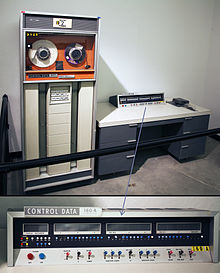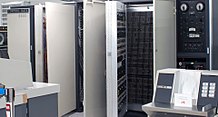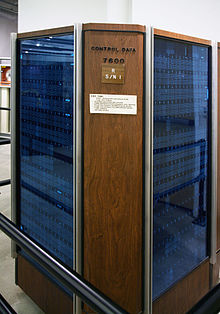Control Data Corporation
During World War II the U.S. Navy had built up a classified[1] team of engineers to build codebreaking machinery[2] for both Japanese and German electro-mechanical ciphers.[3] Eventually they found their solution: John Parker, the owner of a Chase Aircraft affiliate named Northwestern Aeronautical Corporation[1] located in St. Paul, Minnesota, was about to lose all his contracts due to the ending of the war.Parker was obviously wary, but after several meetings with increasingly high-ranking Naval officers it became apparent that whatever it was, they were serious, and he eventually agreed to give this team a home in his military glider factory.Of the members forming CDC, William Norris was the unanimous choice to become the chief executive officer of the new company.Legend has it that the 1604 designation was chosen by adding CDC's first street address (501 Park Avenue) to Cray's former project, the ERA-Univac 1103.This required radical changes in design, and as the project "dragged on" — it had gone on for about four years by then — the management got increasingly upset and it demanded greater oversight.Another side effect of Norris's attempts to diversify was the creation of a number of service bureaus that ran jobs on behalf of smaller companies that could not afford to buy computers.[17] Meanwhile, at the new Chippewa Falls lab, Seymour Cray, Jim Thornton, and Dean Roush put together a team of 34 engineers, which continued work on the new computer design.That way, the CPU could devote all of its time and circuitry to processing actual data, while the other controllers dealt with the mundane tasks like punching cards and running disk drives.Using late-model compilers, the machine attained a standard mathematical operations rate of 500 kiloFLOPS, but handcrafted assembly managed to deliver approximately 1 megaFLOPS.Two hundred people were gathered on the U.S. West Coast to work on the project, away from corporate prodding, in an attempt to mirror Cray's off-site lab.Norris did not take this tactic, dubbed as fear, uncertainty and doubt (FUD), lying down, and in an extensive antitrust lawsuit launched against IBM a year later, he eventually won a settlement valued at $80 million.SPIN explored all of these approaches, and eventually delivered a 28" diameter fixed disk and a smaller multi-platter 14" removable disk-pack system.The smaller size and shorter signal paths allowed the 8600 to run at much higher clock speeds which, together with faster memory, provided most of the performance gains.An abundance of hot-running solder joints ensured that the machines did not work reliably; Cray recognized that a re-design was needed.Unlike the 8600's "four computers in one box" solution to the speed problem, the STAR was a new design using a unit that we know today as the vector processor.Since these two projects competed for limited funds during the late 1960s, Norris felt that the company could not support simultaneous development of the STAR and a complete redesign of the 8600.Also, during the lunch at a local country club, Norris signed a huge stack of certificates attesting to the record which were printed by the Star 100 on printer paper produced in our Lincoln, Nebraska plant.A front page Wall Street Journal news article resulted in acquiring a new user, Allis-Chalmers, for simulation of a damaged hydroelectric turbine in a Norwegian mountain hydropower plant.Sales of the STAR were weak, but Control Data Corp. produced a successor system, the Cyber 200/205, that gave Cray Research some competition.Magnetic Peripherals Inc., later Imprimis Technology, was originally a joint venture with Honeywell formed in 1975 to manufacture HDDs for both companies.Its CDC Wren series drives were particularly popular with high end users, although it was behind the capacity growth and performance curves of numerous startups such as Micropolis, Atasi, Maxtor, and Quantum.CDC also co-developed the now universal Advanced Technology Attachment (ATA) interface with Compaq and Western Digital, which was aimed at lowering the cost of adding low-performance drives.CDC founded a separate division called Rigidyne in Simi Valley, California, to develop 3.5-inch drives using technology from the Wren series.In 1986, Sandy Weill convinced the Control Data management to spin off their Commercial Credit subsidiary to prevent the company's potential liquidation.[27] In 1990 the majority of Ticketron's assets and business, with the exception of a small antitrust carve-out for Broadway's "Telecharge" business-unit, were bought by The Carlyle Group who sold it the following year to rival Ticketmaster.[34] CDC decided to fight for the high-performance niche, but Norris considered that the company had become moribund and unable to quickly design competitive machines.In 1983 he set up a spinoff company, ETA Systems, whose design goal was a machine processing data at 10 GFLOPs, about 40 times the speed of the Cray-1.For about $16 million, it will acquire IBM's Service Bureau Corp., a subsidiary that processes customers' data and sells time on its own computers.William C. Norris, Control Data's one-man-gang chairman, said that the daring suit had turned out to be 'one of the best management decisions in our history.' ..."




Control Data (album)SupercomputingCeridianBloomington, MinnesotaSeymour CrayWilliam NorrismainframesupercomputercomputerBurroughs CorporationDigital Equipment CorporationNCR CorporationGeneral ElectricHoneywellUNIVACCray ResearchDayforceWorld War IIU.S. NavyJapaneseGermanciphersWashington, D.C.Chase AircraftSt. Paul, Minnesotaclearancemilitary gliderEngineering Research Associatesstored programUnivac 1101ERA 1103UNIVAC 1103CongressRemington Randdrum memorySperry CorporationSperry RandUNIVAC IIMinneapolischief executive officerNaval Tactical Data SystemtransistorCDC 1604Naval Postgraduate SchoolMonterey, CaliforniaCDC 160AminicomputersCDC 3000Chippewa Falls, WisconsinHighland ParkCard ReaderCard Punchtape drivesdrum printersHolley CarburetorRochester, MichiganDetroitHolley Computer Productspunched cardoptical character recognitionRockville, MDComputer Peripherals IncCentronicsservice bureausvocational schoolCDC 6000 seriesFairchild SemiconductorgermaniumCDC 6600I/O processorscore memorycompilerskiloFLOPSassemblyCDC 6400CDC 6500FORTRANUniversity of MinnesotaU.S. West CoastSystem/360fear, uncertainty and doubtantitrustService Bureau Corporationhard diskmemory drumsCDC 7600CDC 8600pipeliningoperating systemsolderedcircuit boardsCDC STAR-100CDC Cybervector processorNetwork Systems CorporationGuinnessGuinness Book of World Recordscountry clubLincoln, Nebraskahalf-toneWall Street JournalhydroelectricturbineCray-1black project64-bitPLATO computer-aided learning systemBoca ResearchSperryStorage Module DeviceBrynmawrSouth WalesOklahoma CityCDC WrenMicropolisMaxtorQuantumAdvanced Technology AttachmentCompaqWestern DigitalSimi ValleyImprimis TechnologySeagate TechnologyArbitronTicketronLoews Inc.